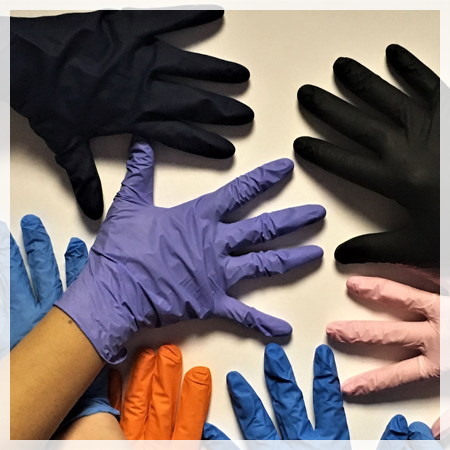Currency
September 17, 2017

Disposable gloves play an important role in job safety and task efficiency. A disposable glove re-evaluation can lead to improved protection, efficiency and possible glove consolidation. Every facility has its own unique complex processes and tasks. A close examination of each process and the elements the user comes in contact with will lead to the best glove choice.

If employees work with chemicals, there is information available to guide the glove choice. OSHA provides a chemical resistance chart by glove type on page 26 of Publication #3151, Personal Protection Equipment, that you may access by going to www.osha.gov/Publications/osha3151.pdf. It provides a list of chemicals and rates all protective gloves by type, including latex/rubber and nitrile. When selecting chemical-resistant gloves, please refer to the manufacturer’s recommendations, especially if the gloved hand(s) will be immersed in the chemical.
OSHA regulations require health care workers to use exam gloves to protect them from occupational exposure to blood or bodily fluids that are potentially infectious. Exam grade gloves are regulated and tested to reduce the risk of exposure to bloodborne pathogens.
For vinyl users who are routinely exposed to sharp objects or abrasion, consider a thicker nitrile or latex glove that will offer more protection. A disposable glove with a thickness of 6 mil or higher should be considered for evaluation in these environments. For more tasks with more frequent and dangerous exposure to abrasion a non-disposable/reusable glove may be more suitable.
Tasks that involve assembling components or handling small items require appropriate glove material and good fit. In general, a “thinner” glove will offer better dexterity and less hand fatigue for the user. Also, natural rubber latex is a good option for natural fit, comfort and dexterity. For users allergic to latex, nitrile gloves have similar qualities to latex and are a common choice to transition away from latex. Disposable nitrile gloves with a higher mil thickness can be an alternative to loose-fitting, reusable gloves, for better hand dexterity
Assessing glove change frequency can greatly impact glove choice. Using a higher quality glove than the task requires becomes especially costly when frequent glove changes are needed. Conversely, if the gloves are being changed out because of glove failure, then a higher quality glove may be needed.
Glove texturing is not highly visible, but can be examined through touch and comparison of gloves. A textured glove can greatly improve grip in both wet and dry environments. Disposable gloves are available with no texturing, fingertip texturing or entire glove texturing (fully textured). Gloves with a heavy embossing/texture normally should be produced with a heavier mil thickness because they are more prone to pinholes. Fully textured gloves are recommended for jobs that have gripping tasks, and in slippery or oily conditions.
A health and safety manager at a contract packager and manufacturer of liquid personal care products supplied a vinyl glove for his production group. They noticed that the gloves were tearing frequently, and the employees were changing gloves often. He decided to make a switch to a nitrile glove. They found the glove to provide better protection, more durability, and more chemical protection when needed. Also, the textured nitrile gloves provide a better grip for handling small components or wet bottles. Although they were more expensive, less frequent glove changes offset much of the cost of a higher quality glove.
A regional manager at a grain elevator and agriculture equipment repair and maintenance company uses a heavy duty reusable glove for his employees. The staff repairs and maintains equipment, often in the presence wet and decaying grain product. Reusable or non-disposable gloves are thicker and looser fitting than disposable gloves. Reusable gloves typically range from 15 to 22 mil in thickness. They found their dexterity was comprised with thick reusable gloves when working with nuts, bolts and other small objects. They are now investigating less expensive, thinner 6 and 8 mil heavy duty disposable gloves to improve glove fit for better hand agility.
A thorough evaluation of current disposable glove specifications and usage can provide insight for improved glove selection. Consideration for glove consolidation should be evaluated in situations where similar gloves are being used for multiple tasks. When considering glove re-assessment, a glove specialist can provide new glove options, as well as the optimal gloves for safety, efficiency and value relative to your facility.

Chemicals
If employees work with chemicals, there is information available to guide the glove choice. OSHA provides a chemical resistance chart by glove type on page 26 of Publication #3151, Personal Protection Equipment, that you may access by going to www.osha.gov/Publications/osha3151.pdf. It provides a list of chemicals and rates all protective gloves by type, including latex/rubber and nitrile. When selecting chemical-resistant gloves, please refer to the manufacturer’s recommendations, especially if the gloved hand(s) will be immersed in the chemical.
Bloodborne pathogens
OSHA regulations require health care workers to use exam gloves to protect them from occupational exposure to blood or bodily fluids that are potentially infectious. Exam grade gloves are regulated and tested to reduce the risk of exposure to bloodborne pathogens.
Cut or puncture resistance
For vinyl users who are routinely exposed to sharp objects or abrasion, consider a thicker nitrile or latex glove that will offer more protection. A disposable glove with a thickness of 6 mil or higher should be considered for evaluation in these environments. For more tasks with more frequent and dangerous exposure to abrasion a non-disposable/reusable glove may be more suitable.
Dexterity and hand agility
Tasks that involve assembling components or handling small items require appropriate glove material and good fit. In general, a “thinner” glove will offer better dexterity and less hand fatigue for the user. Also, natural rubber latex is a good option for natural fit, comfort and dexterity. For users allergic to latex, nitrile gloves have similar qualities to latex and are a common choice to transition away from latex. Disposable nitrile gloves with a higher mil thickness can be an alternative to loose-fitting, reusable gloves, for better hand dexterity
Glove change frequency
Assessing glove change frequency can greatly impact glove choice. Using a higher quality glove than the task requires becomes especially costly when frequent glove changes are needed. Conversely, if the gloves are being changed out because of glove failure, then a higher quality glove may be needed.
Grip and texture
Glove texturing is not highly visible, but can be examined through touch and comparison of gloves. A textured glove can greatly improve grip in both wet and dry environments. Disposable gloves are available with no texturing, fingertip texturing or entire glove texturing (fully textured). Gloves with a heavy embossing/texture normally should be produced with a heavier mil thickness because they are more prone to pinholes. Fully textured gloves are recommended for jobs that have gripping tasks, and in slippery or oily conditions.
Glove evaluation case examples
A health and safety manager at a contract packager and manufacturer of liquid personal care products supplied a vinyl glove for his production group. They noticed that the gloves were tearing frequently, and the employees were changing gloves often. He decided to make a switch to a nitrile glove. They found the glove to provide better protection, more durability, and more chemical protection when needed. Also, the textured nitrile gloves provide a better grip for handling small components or wet bottles. Although they were more expensive, less frequent glove changes offset much of the cost of a higher quality glove.
A regional manager at a grain elevator and agriculture equipment repair and maintenance company uses a heavy duty reusable glove for his employees. The staff repairs and maintains equipment, often in the presence wet and decaying grain product. Reusable or non-disposable gloves are thicker and looser fitting than disposable gloves. Reusable gloves typically range from 15 to 22 mil in thickness. They found their dexterity was comprised with thick reusable gloves when working with nuts, bolts and other small objects. They are now investigating less expensive, thinner 6 and 8 mil heavy duty disposable gloves to improve glove fit for better hand agility.
A thorough evaluation of current disposable glove specifications and usage can provide insight for improved glove selection. Consideration for glove consolidation should be evaluated in situations where similar gloves are being used for multiple tasks. When considering glove re-assessment, a glove specialist can provide new glove options, as well as the optimal gloves for safety, efficiency and value relative to your facility.









